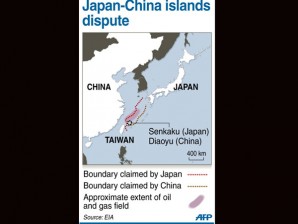
Four maritime surveillance ships entered the waters shortly after 12:30 p.m. (0330 GMT), where they remained for around six hours, ignoring demands from Japan’s coastguard to leave.
“Patrol ships from our agency have been telling them to sail outside of our territorial waters. There has not been any response” from the Chinese ships, the agency said.
It was the first time in about a week that Chinese ships had entered the waters, following a lull in a diplomatic row over the sovereignty of the islands known as the Senkakus in Japan and Diaoyus in China.
Foreign Minister Koichiro Gemba said the Japanese government lodged an immediate protest with China over the latest case, telling reporters: “We want the Chinese side to exercise self-restraint.”
In Beijing, foreign ministry spokesman Hong Lei said China was “strongly unsatisfied” with moves by “Japanese right-wingers” to enter waters around the islands.
“If left unchecked, such provocative behavior could complicate the situation, and China is paying close attention,” an online statement said.
Official Chinese vessels repeatedly sailed into the archipelago’s waters until Monday last week, defying warnings from Japan’s well-equipped coastguard.
The islands lie in rich fishing grounds and on key shipping lanes. The seabed in the area is also believed to harbor mineral reserves.
Last week Chinese and Japanese diplomats at the UN General Assembly in New York traded insults, with China’s Foreign Minister Yang Jiechi accusing Japan of theft.
Japan’s deputy UN ambassador Kazuo Kodama retorted that the islands were legally Japanese territory and said “an assertion that Japan took the islands from China cannot logically stand.”
Historical grievances stemming from Japan’s wartime expansionism also complicate the argument, as does a claim of ownership by Taiwan.
That claim was pressed on Tuesday last week when dozens of fishing boats were escorted into island waters by the Taiwanese coastguard, sparking water cannon exchanges with Japanese coastguard vessels.
The decades-old dispute came to the fore earlier this year when the China-baiting governor of Tokyo, Shintaro Ishihara, announced he wanted to buy the island chain from its private Japanese landowner.
Nationalists from both sides staged island landings before Prime Minister Yoshihiko Noda stepped in to outbid Ishihara, who had amassed well over a billion yen ($12.8 million) in public donations towards the cost.
The government completed its purchase of three of the five islands in the chain – it already owned one and leases the fifth – on September 11.
Observers said Noda’s move to nationalize the islands had been an attempt to cool down a potential international problem.
But Beijing reacted furiously and unleashed diplomatic vitriol on Tokyo, while tens of thousands of protesters poured onto the streets in cities across China.
In demonstrations that commentators said had at least tacit approval from the authorities, Japanese businesses were targeted for violence and arson, with some forced to close temporarily.
The protests escalated, culminating a fortnight ago on the 81st anniversary of the Mukden Incident, an episode marking the beginning of Japan’s occupation of swathes of modern-day China.
Chinese state media announced late last week that the Communist Party congress – at which a generational leadership change is expected to take place – would begin on November 8.
China-watchers had said a behind-the-scenes tussle over who will occupy key positions has been going on for some time, complicating Beijing’s behavior over the island dispute.
Japan’s political scene is also fragile and prey to nationalist sentiment. A weakened Noda is expected to call a general election over the coming months in which his fragmenting party looks set to fare badly.